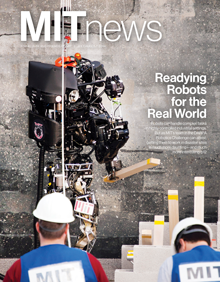Letters
Remembering Seth Teller
Seth Teller’s recent death came as a blow to the MIT community. Seth was a gifted computer scientist, a devoted educator, and an amazing colleague. Full of ideas and enthusiasm, he was driven to make bold rather than incremental advances. When faced with the choice between “an easy way” and “the right way” to pursue a technologically ambitious problem, Seth always chose the more difficult path, relishing the scientific challenge and recognizing the greater potential benefits.

Since 2012, Seth had been coleading MIT’s DARPA Robotics Challenge team, which had made it through several rounds of competition to earn a much sought-after slot in the final round (“Readying Robots for the Real World,” July/August 2014). My colleague Russ Tedrake will lead the team into next year’s competition. I know that they will make Seth proud.
I had the honor of working with Seth on MIT’s team in the 2007 DARPA Urban Challenge, in which the goal was to build a robot that could drive a 60-mile course autonomously in traffic. Seth served as our team lead for perception. Armed with more sensors and computers than any other team, he and his students created a vision- and lidar-based road-following system that enabled our vehicle to navigate curved roads with only sparse GPS waypoints. In the race, we finished in fourth place, more than an hour after the top three. Although we could have achieved better performance by closely following an a priori global map provided to the competitors, we chose instead to rely more on our robot’s autonomous perception of its environment for navigation. Our team’s use of advanced techniques for perception and planning led in the years that followed to numerous academic papers and to the development of important new algorithms, such as the RRT* algorithm for optimal randomized motion planning.
Seth brought his DARPA research experiences into the classroom in a profound way. An inspirational teacher, he co-developed and taught 6.141 Robotics: Science and Systems, a cornerstone of MIT’s robotics curriculum, in which students work in teams to create a fully operational autonomous mobile robot that combines perception, navigation, manipulation, planning, and control. Like Seth himself, this class embodies MIT’s “mind and hand” spirit, combining advanced algorithms with real-world system-building, experimentation, and productive collegiality.
Seth “lived in the future”—envisioning the progression from the impossible to the possible, the impractical to the practical, and the costly to the affordable to create technologies that can benefit the lives of many. He has left a profound legacy at MIT and in the robotics community worldwide. Our thoughts and condolences are with his family on their loss. We will miss him dearly.
John Leonard
Professor of mechanical and ocean engineering, MIT
An Adventure with Dr. Zapol
I had the privilege of participating twice in Warren Zapol’s adventures on the ice of McMurdo Bay in Antarctica (“Dr. Adventure,” July/August 2014). In 1983 we measured arterial blood gases in freely diving Weddell seals, providing evidence of how these animals avoid nitrogen narcosis and decompression sickness when they dive to depths of hundreds of meters for up to one hour (Science, 1985). Ten years later we went back on the ice to test our hypothesis that nitric oxide (NO), a potent endogenous vasodilator, may play an important role in reëstablishing pulmonary blood flow after dives. Using a large meteorological balloon that we’d brought to the laboratory on the rear of a diesel truck, we began measuring NO in exhaled air from Weddell seals. When our first attempt indeed revealed a substantial NO concentration, Warren very enthusiastically declared: “Hey, we are going to be in Science!” But much to our despair, when we moved our rather sophisticated measuring equipment to the ice field next to the seals, we were unable to reproduce this result. After several more painstaking experiments, we discovered that the NO in the meteorological balloon had not come from exhaled air but from the exhaust fumes of the truck. In fact, the expired NO concentration was virtually zero. Now Warren less enthusiastically declared: “We are only going to be in Nature!” Our report about these studies had to have a completely different focus, and it took me more than a decade to publish (Respiration & Neurophysiology, 2008).
Konrad Falke
Potsdam, Germany
Tell us what you think
E-mail mitnews@technologyreview.com
Write MIT News One Main Street, 13th Floor Cambridge, MA 02142
Keep Reading
Most Popular
Large language models can do jaw-dropping things. But nobody knows exactly why.
And that's a problem. Figuring it out is one of the biggest scientific puzzles of our time and a crucial step towards controlling more powerful future models.
The problem with plug-in hybrids? Their drivers.
Plug-in hybrids are often sold as a transition to EVs, but new data from Europe shows we’re still underestimating the emissions they produce.
Google DeepMind’s new generative model makes Super Mario–like games from scratch
Genie learns how to control games by watching hours and hours of video. It could help train next-gen robots too.
How scientists traced a mysterious covid case back to six toilets
When wastewater surveillance turns into a hunt for a single infected individual, the ethics get tricky.
Stay connected
Get the latest updates from
MIT Technology Review
Discover special offers, top stories, upcoming events, and more.